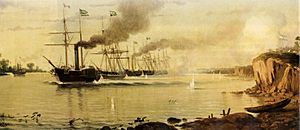Battle of the Tonelero Pass facts for kids
Quick facts for kids The Passage of the Tonelero |
|||||||
|---|---|---|---|---|---|---|---|
| Part of the Platine War | |||||||
 Brazilian warships passing the Tonelero defences |
|||||||
|
|||||||
| Belligerents | |||||||
| Commanders and leaders | |||||||
| Strength | |||||||
| 4 steamships 3 corvettes 1 brig 60 guns |
2,000 16 guns |
||||||
| Casualties and losses | |||||||
| 4 killed 5 wounded Corvette Dona Francisca hit by 3 cannon balls Steamship Recife heavily damaged Steamship Dom Afonso damaged Brig Caliope heavily damaged |
Brazilian accounts: 8 killed 20 wounded Argentine accounts: 1 killed |
||||||
The Passage of the Tonelero was an important naval battle. It happened on December 17, 1851, on the Paraná River in Argentina. This battle was part of a bigger conflict called the Platine War. It involved warships from the Brazilian Imperial Navy and soldiers from the Argentine Confederation.
Contents
What Was the Platine War?
The Platine War was a conflict in South America during the 1850s. It involved several countries, including Brazil, Argentina, and Uruguay. The main reason for the war was control over the Río de la Plata region and its important rivers. These rivers were like highways for trade and travel.
Argentina, led by Juan Manuel de Rosas, wanted to control the region. Brazil and its allies wanted to keep the rivers open for everyone. The Passage of the Tonelero was a key moment in this war. It showed how important it was to control the rivers.
The Battle at Tonelero Pass
On December 17, 1851, the Brazilian fleet was ready to move. They were near a cliff called Acevedo on the Paraná River. Their goal was to break through the Argentine defenses. These defenses were set up at a narrow part of the river known as the Tonelero Pass.
Brazilian Fleet's Strength
The Brazilian fleet had eight warships. Four of them were steam-powered corvettes: the Dom Pedro, Dom Pedro II, Dom Afonso, and Recife. These powerful steamships towed two sailing corvettes, the Dona Francisca and União, and one brig called Calíope.
On board the flagship, Dom Afonso, were important leaders. These included Brigadier General Marques de Sousa from Brazil. Also present were Argentine allies like Colonel Wenceslao Paunero, Lieutenant-Colonel Bartolomé Mitre, and Lieutenant-Colonel Domingo Faustino Sarmiento. The ships were also carrying half of the Brazilian army's 1st Division. The rest of the soldiers were waiting in Colonia del Sacramento, Uruguay.
Argentine Defenses
The Argentine forces were led by Lucio Norberto Mansilla. He was the son-in-law of Argentina's leader, Juan Manuel de Rosas. Mansilla had about 2,000 soldiers. They were armed with 16 artillery cannons. Their plan was to stop the Brazilian ships from passing.
The Fight Begins
For about an hour, the Argentine cannons fired over 450 rounds. They aimed at the Brazilian ships. The ships were hit, but the damage was not severe. Four Brazilian sailors were killed and five were wounded. The Brazilian warships fired back at the Argentine positions. However, their shots did not cause much damage to the Argentine soldiers. Brazilian reports said eight Argentines were killed and twenty wounded. Argentine reports claimed only one person was killed.
Some reports suggest the Argentine cannons did cause significant damage to the Brazilian warships. For example, the corvette Dona Francisca was hit by three cannonballs. The steamship Recife and the brig Calíope were also heavily damaged. The steamship Dom Afonso also suffered some damage.
Troops Land and Mansilla Retreats
After passing the defenses, the Brazilian squadron landed their troops. They disembarked at Diamante in Entre Ríos. Some of the ships then went back to pick up the other battalions. These battalions had stayed behind in Colonia.
Mansilla thought the Brazilian soldiers would land right where his main defenses were. But when the ships passed and landed elsewhere, he decided to retreat. Mansilla and his men fled, leaving behind all their cannons and other equipment.
What Happened Next?
The successful passage of the Tonelero was a big win for Brazil. It allowed their ships and troops to move deeper into Argentine territory. This battle was a key step that led to the Battle of Caseros. The Battle of Caseros happened a few months later and was a major turning point in the Platine War.
See also
 In Spanish: Batalla del Paso del Tonelero para niños
In Spanish: Batalla del Paso del Tonelero para niños
- Battle of Caseros
- Platine War

